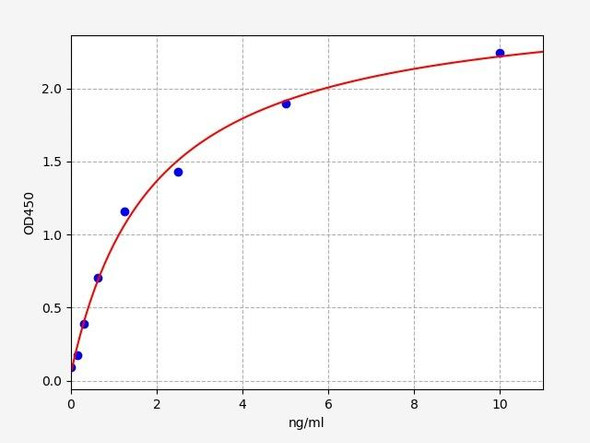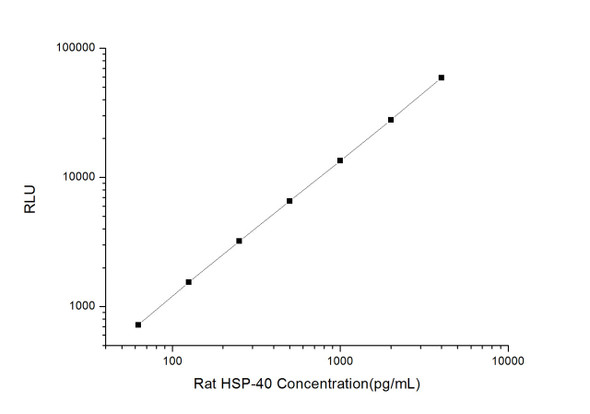Rat Signaling ELISA Kits 3
Rat HSP-60 (Heat Shock Protein 60) CLIA Kit (RTES00278)
- SKU:
- RTES00278
- Product Type:
- ELISA Kit
- ELISA Type:
- CLIA Kit
- Size:
- 96 Assays
- Sensitivity:
- 37.5pg/mL
- Range:
- 62.5-4000pg/mL
- ELISA Type:
- Sandwich
- Reactivity:
- Rat
- Sample Type:
- Serum, plasma and other biological fluids
Description
| Assay type: | Sandwich |
| Format: | 96T |
| Assay time: | 4.5h |
| Reactivity: | Rat |
| Detection method: | Chemiluminescence |
| Detection range: | 62.50-4000 pg/mL |
| Sensitivity: | 37.50 pg/mL |
| Sample volume: | 100µL |
| Sample type: | Serum, plasma and other biological fluids |
| Repeatability: | CV < 15% |
| Specificity: | This kit recognizes Rat HSP-60 in samples. No significant cross-reactivity or interference between Rat HSP-60 and analogues was observed. |
This kit uses Sandwich-CLIA as the method. The micro CLIA plate provided in this kit has been pre-coated with an antibody specific to Rat Hsp-60. Standards or samples are added to the appropriate micro CLIA plate wells and combined with the specific antibody. Then a biotinylated detection antibody specific for Rat Hsp-60 and Avidin-Horseradish Peroxidase (HRP) conjugate are added to each micro plate well successively and incubated. Free components are washed away. The substrate solution is added to each well. Only those wells that contain Rat Hsp-60, biotinylated detection antibody and Avidin-HRP conjugate will appear fluorescence. The Relative light unit (RLU) value is measured spectrophotometrically by the Chemiluminescence immunoassay analyzer. The RLU value is positively associated with the concentration of Rat Hsp-60. The concentration of Rat Hsp-60 in the samples can be calculated by comparing the RLU of the samples to the standard curve.
| UniProt Protein Function: | HSP60: Implicated in mitochondrial protein import and macromolecular assembly. May facilitate the correct folding of imported proteins. May also prevent misfolding and promote the refolding and proper assembly of unfolded polypeptides generated under stress conditions in the mitochondrial matrix. Interacts with HRAS. Interacts with HBV protein X and HTLV-1 protein p40tax. Belongs to the chaperonin (HSP60) family. |
| UniProt Protein Details: | Protein type:Chaperone; Mitochondrial Cellular Component: Golgi apparatus; extracellular space; protein complex; cell surface; rough endoplasmic reticulum; intracellular membrane-bound organelle; mitochondrion; early endosome; coated pit; cytosol; lipid raft; secretory granule; mitochondrial crista; membrane; mitochondrial matrix; mitochondrial inner membrane; cytoplasm; plasma membrane; lipopolysaccharide receptor complex; cyclin-dependent protein kinase activating kinase holoenzyme complex; myelin sheath Molecular Function:insulin binding; protein binding; protease binding; protein heterodimerization activity; lipopolysaccharide binding; p53 binding; chaperone binding; ubiquitin protein ligase binding; double-stranded RNA binding; protein complex binding; misfolded protein binding; ATP binding Biological Process: B cell proliferation; T cell activation; positive regulation of apoptosis; positive regulation of interleukin-12 production; isotype switching to IgG isotypes; response to lipopolysaccharide; response to organic cyclic substance; positive regulation of interleukin-10 production; response to organic substance; protein refolding; negative regulation of neuron apoptosis; positive regulation of T cell mediated immune response to tumor cell; positive regulation of interferon-alpha production; positive regulation of macrophage activation; caspase activation; response to drug; B cell activation; chaperone cofactor-dependent protein folding; protein stabilization; positive regulation of interleukin-6 production; B cell cytokine production; detection of misfolded protein; response to cocaine; response to unfolded protein; response to ATP; MyD88-dependent toll-like receptor signaling pathway; positive regulation of interferon-gamma production; 'de novo' protein folding; response to hydrogen peroxide; response to estrogen stimulus; response to heat; response to hypoxia; positive regulation of T cell activation; negative regulation of apoptosis; positive regulation of inflammatory response |
| NCBI Summary: | a stress-inducible molecular chaperone which participates in protein folding [RGD, Feb 2006] |
| UniProt Code: | P63039 |
| NCBI GenInfo Identifier: | 51702230 |
| NCBI Gene ID: | 63868 |
| NCBI Accession: | P63039. 1 |
| UniProt Secondary Accession: | P63039,P19226, P19227, P97602, |
| UniProt Related Accession: | P63039 |
| Molecular Weight: | 60,955 Da |
| NCBI Full Name: | 60 kDa heat shock protein, mitochondrial |
| NCBI Synonym Full Names: | heat shock protein 1 (chaperonin) |
| NCBI Official Symbol: | Hspd1 |
| NCBI Official Synonym Symbols: | Hsp60; Hspd1-30p |
| NCBI Protein Information: | 60 kDa heat shock protein, mitochondrial; CPN60; HSP-60; HSP-65; chaperonin 60; 60 kDa chaperonin; heat shock 60kDa protein 1; heat shock protein 60 (liver); mitochondrial matrix protein P1; heat shock 60kD protein 1 (chaperonin) |
| UniProt Protein Name: | 60 kDa heat shock protein, mitochondrial |
| UniProt Synonym Protein Names: | 60 kDa chaperonin; Chaperonin 60; CPN60; HSP-65; Heat shock protein 60; HSP-60; Hsp60; Mitochondrial matrix protein P1 |
| Protein Family: | 60 kDa heat shock protein |
| UniProt Gene Name: | Hspd1 |
| UniProt Entry Name: | CH60_RAT |
As the RLU values of the standard curve may vary according to the conditions of the actual assay performance (e. g. operator, pipetting technique, washing technique or temperature effects), the operator should establish a standard curve for each test. Typical standard curve and data is provided below for reference only.
| Concentration (pg/mL) | RLU | Average | Corrected |
| 4000 | 58146 60016 | 59081 | 59046 |
| 2000 | 27191 28527 | 27859 | 27824 |
| 1000 | 13961 13007 | 13484 | 13449 |
| 500 | 6024 7186 | 6605 | 6570 |
| 250 | 3430 3056 | 3243 | 3208 |
| 125 | 1644 1518 | 1581 | 1546 |
| 62.50 | 706 804 | 755 | 720 |
| 0 | 34 36 | 35 | -- |
Precision
Intra-assay Precision (Precision within an assay): 3 samples with low, mid range and high level Rat HSP-60 were tested 20 times on one plate, respectively.
Inter-assay Precision (Precision between assays): 3 samples with low, mid range and high level Rat HSP-60 were tested on 3 different plates, 20 replicates in each plate.
| Intra-assay Precision | Inter-assay Precision | |||||
| Sample | 1 | 2 | 3 | 1 | 2 | 3 |
| n | 20 | 20 | 20 | 20 | 20 | 20 |
| Mean (pg/mL) | 201.95 | 518.97 | 1385.44 | 184.65 | 563.89 | 1265.86 |
| Standard deviation | 17.49 | 46.71 | 151.15 | 15.22 | 41.05 | 136.33 |
| C V (%) | 8.66 | 9.00 | 10.91 | 8.24 | 7.28 | 10.77 |
Recovery
The recovery of Rat HSP-60 spiked at three different levels in samples throughout the range of the assay was evaluated in various matrices.
| Sample Type | Range (%) | Average Recovery (%) |
| Serum (n=5) | 85-99 | 92 |
| EDTA plasma (n=5) | 99-112 | 105 |
| Cell culture media (n=5) | 97-112 | 103 |
Linearity
Samples were spiked with high concentrations of Rat HSP-60 and diluted with Reference Standard & Sample Diluent to produce samples with values within the range of the assay.
| Serum (n=5) | EDTA plasma (n=5) | Cell culture media (n=5) | ||
| 1:2 | Range (%) | 96-108 | 102-118 | 91-108 |
| Average (%) | 103 | 109 | 99 | |
| 1:4 | Range (%) | 93-109 | 88-100 | 93-110 |
| Average (%) | 101 | 94 | 101 | |
| 1:8 | Range (%) | 94-109 | 89-103 | 88-99 |
| Average (%) | 101 | 95 | 94 | |
| 1:16 | Range (%) | 98-114 | 87-99 | 88-102 |
| Average (%) | 104 | 93 | 95 |
An unopened kit can be stored at 4°C for 1 month. If the kit is not used within 1 month, store the items separately according to the following conditions once the kit is received.
| Item | Specifications | Storage |
| Micro CLIA Plate(Dismountable) | 8 wells ×12 strips | -20°C, 6 months |
| Reference Standard | 2 vials | |
| Concentrated Biotinylated Detection Ab (100×) | 1 vial, 120 µL | |
| Concentrated HRP Conjugate (100×) | 1 vial, 120 µL | -20°C(shading light), 6 months |
| Reference Standard & Sample Diluent | 1 vial, 20 mL | 4°C, 6 months |
| Biotinylated Detection Ab Diluent | 1 vial, 14 mL | |
| HRP Conjugate Diluent | 1 vial, 14 mL | |
| Concentrated Wash Buffer (25×) | 1 vial, 30 mL | |
| Substrate Reagent A | 1 vial, 5 mL | 4°C (shading light) |
| Substrate Reagent B | 1 vial, 5 mL | 4°C (shading light) |
| Plate Sealer | 5 pieces | |
| Product Description | 1 copy | |
| Certificate of Analysis | 1 copy |
- Set standard, test sample and control (zero) wells on the pre-coated plate and record theirpositions. It is recommended to measure each standard and sample in duplicate. Note: addall solutions to the bottom of the plate wells while avoiding contact with the well walls. Ensuresolutions do not foam when adding to the wells.
- Aliquot 100µl of standard solutions into the standard wells.
- Add 100µl of Sample / Standard dilution buffer into the control (zero) well.
- Add 100µl of properly diluted sample (serum, plasma, tissue homogenates and otherbiological fluids. ) into test sample wells.
- Cover the plate with the sealer provided in the kit and incubate for 90 min at 37°C.
- Aspirate the liquid from each well, do not wash. Immediately add 100µL of BiotinylatedDetection Ab working solution to each well. Cover the plate with a plate seal and gently mix. Incubate for 1 hour at 37°C.
- Aspirate or decant the solution from the plate and add 350µL of wash buffer to each welland incubate for 1-2 minutes at room temperature. Aspirate the solution from each well andclap the plate on absorbent filter paper to dry. Repeat this process 3 times. Note: a microplatewasher can be used in this step and other wash steps.
- Add 100µL of HRP Conjugate working solution to each well. Cover with a plate seal andincubate for 30 min at 37°C.
- Aspirate or decant the solution from each well. Repeat the wash process for five times asconducted in step 7.
- Add 100µL of Substrate mixture solution to each well. Cover with a new plate seal andincubate for no more than 5 min at 37°C. Protect the plate from light.
- Determine the RLU value of each well immediately.






